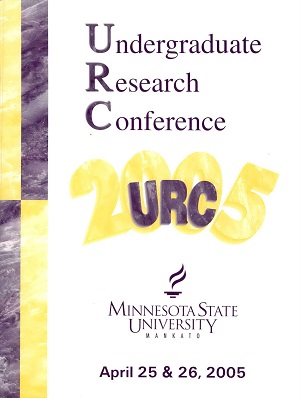Hemispheric Lateralization, Gender Differences in the Processing of Rapidly Presented Visual Information
Location
CSU 253
Start Date
25-4-2005 1:15 PM
End Date
25-4-2005 3:15 PM
Student's Major
Psychology
Student's College
Social and Behavioral Sciences
Mentor's Name
Robert Widner
Mentor's Department
Psychology
Description
Dementia of the Alzheimer Type (DAT) is a chronic, progressive disorder that affects 4 million Americans with the number expected to increase several-fold as more people live longer. Differentiating cognitive declines that result from normal aging from declines associated with DAT is important for theoretical as well as practical reasons. The ability to differentiate cognitive declines allows for early detection and intervention; we know that the earlier the intervention the greater the likelihood of a positive outcome (e.g., Widner Adames, & Muller, 1997; Widner, Mueller, & Adames, 1997). Of particular relevance in the present study is the finding that DAT disrupts visual attention (e.g., difficulty in recognizing faces; Parasuraman, Greenwood, Haxby, & Grady, 1992). Widner and colleagues determined that there is an age-related difference in the processing of rapidly presented visual information (e.g., single letters presented at a rate of 90 ms.) with older adults (M • age = 69) taking three times longer to identify such information relative to college students. In the present study we found that the right hemisphere plays a greater role in the processing of rapidly presented information for males than for females. On the other hand when we examined the contribution of the left hemisphere to the processing of rapidly presented information we found no gender difference. The present findings are of particular significance because we can now start to localize the neural structures that may be affected by AD early on in the disease; that is, we may have a way in which we can detect AD before we observe any behavioral changes as a function of the disease.
Hemispheric Lateralization, Gender Differences in the Processing of Rapidly Presented Visual Information
CSU 253
Dementia of the Alzheimer Type (DAT) is a chronic, progressive disorder that affects 4 million Americans with the number expected to increase several-fold as more people live longer. Differentiating cognitive declines that result from normal aging from declines associated with DAT is important for theoretical as well as practical reasons. The ability to differentiate cognitive declines allows for early detection and intervention; we know that the earlier the intervention the greater the likelihood of a positive outcome (e.g., Widner Adames, & Muller, 1997; Widner, Mueller, & Adames, 1997). Of particular relevance in the present study is the finding that DAT disrupts visual attention (e.g., difficulty in recognizing faces; Parasuraman, Greenwood, Haxby, & Grady, 1992). Widner and colleagues determined that there is an age-related difference in the processing of rapidly presented visual information (e.g., single letters presented at a rate of 90 ms.) with older adults (M • age = 69) taking three times longer to identify such information relative to college students. In the present study we found that the right hemisphere plays a greater role in the processing of rapidly presented information for males than for females. On the other hand when we examined the contribution of the left hemisphere to the processing of rapidly presented information we found no gender difference. The present findings are of particular significance because we can now start to localize the neural structures that may be affected by AD early on in the disease; that is, we may have a way in which we can detect AD before we observe any behavioral changes as a function of the disease.
Recommended Citation
Winkelman, Sarah. "Hemispheric Lateralization, Gender Differences in the Processing of Rapidly Presented Visual Information." Undergraduate Research Symposium, Mankato, MN, April 25, 2005.
https://cornerstone.lib.mnsu.edu/urs/2005/poster-session-A/9




